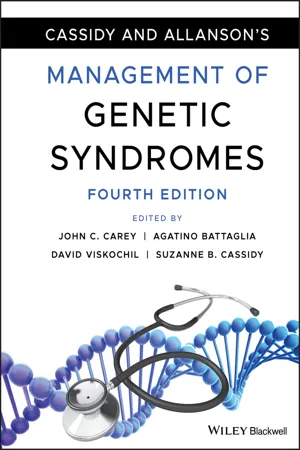
Cassidy and Allanson's Management of Genetic Syndromes
- English
- ePUB (mobile friendly)
- Available on iOS & Android
Cassidy and Allanson's Management of Genetic Syndromes
About this book
MANAGEMENT OF GENETIC SYNDROMES
THE MOST RECENT UPDATE TO ONE OF THE MOST ESSENTIAL REFERENCES ON MEDICAL GENETICS
Cassidy and Allanson's Management of Genetic Syndromes, Fourth Edition is the latest version of a classic text in medical genetics. With newly covered disorders and cutting-edge, up-to-date information, this resource remains the most crucial reference on the management of genetic syndromes in the field of medical genetics for students, clinicians, caregivers, and researchers. The fourth edition includes current information on the identification of genetic syndromes (including newly developed diagnostic criteria), the genetic basis (including diagnostic testing), and the routine care and management for more than 60 genetic disorders.
Written by experts, each chapter includes sections on:
- Incidence
- Diagnostic criteria
- Etiology, pathogenesis and genetics
- Diagnostic testing
- Differential diagnosis
- Manifestations and Management (by system)
The book focuses on genetic syndromes, primarily those involving developmental disabilities and congenital defects. The chapter sections dealing with Manifestations and Management represents the centerpiece of each entry and is unmatched by other genetic syndrome references.
Management of Genetic Syndromes is perfect for medical geneticists, genetic counselors, primary care physicians and all healthcare professionals seeking to stay current on the routine care and management of individuals with genetic disorders.
Frequently asked questions
- Essential is ideal for learners and professionals who enjoy exploring a wide range of subjects. Access the Essential Library with 800,000+ trusted titles and best-sellers across business, personal growth, and the humanities. Includes unlimited reading time and Standard Read Aloud voice.
- Complete: Perfect for advanced learners and researchers needing full, unrestricted access. Unlock 1.4M+ books across hundreds of subjects, including academic and specialized titles. The Complete Plan also includes advanced features like Premium Read Aloud and Research Assistant.
Please note we cannot support devices running on iOS 13 and Android 7 or earlier. Learn more about using the app.
Information
1
AARSKOG SYNDROME
INTRODUCTION
Incidence
Diagnostic Criteria
Table of contents
- COVER
- TABLE OF CONTENTS
- TITLE PAGE
- COPYRIGHT PAGE
- FOREWORD TO THE FOURTH EDITION
- FOREWORD TO THE THIRD EDITION
- FOREWORD TO THE SECOND EDITION
- FOREWORD TO THE FIRST EDITION
- PREFACE
- LIST OF CONTRIBUTORS
- INTRODUCTION
- 1 AARSKOG SYNDROME
- 2 ACHONDROPLASIA
- 3 ALAGILLE SYNDROME
- 4 ALBINISM: OCULAR AND OCULOCUTANEOUS ALBINISM AND HERMANSKY–PUDLAK SYNDROME
- 5 ANGELMAN SYNDROME
- 6 ARTHROGRYPOSIS
- 7 ATR‐X: α THALASSEMIA/MENTAL RETARDATION‐X‐LINKED
- 8 BARDET–BIEDL SYNDROME
- 9 BECKWITH–WIEDEMANN SYNDROME AND HEMIHYPERPLASIA
- 10 CARDIO‐FACIO‐CUTANEOUS SYNDROME
- 11 CHARGE SYNDROME
- 12 COFFIN–LOWRY SYNDROME
- 13 COFFIN–SIRIS SYNDROME
- 14 COHEN SYNDROME
- 15 CORNELIA DE LANGE SYNDROME
- 16 COSTELLO SYNDROME
- 17 CRANIOSYNOSTOSIS SYNDROMES
- 18 DELETION 1p36 SYNDROME
- 19 DELETION 4p: WOLF–HIRSCHHORN SYNDROME
- 20 DELETION 5p SYNDROME
- 21 DELETION 22q11.2 (VELO‐CARDIO‐FACIAL SYNDROME/DIGEORGE SYNDROME)
- 22 DELETION 22q13 SYNDROME: PHELAN–MCDERMID SYNDROME
- 23 DENYS–DRASH SYNDROME, FRASIER SYNDROME, AND WAGR SYNDROME (WT1‐RELATED DISORDERS)
- 24 DOWN SYNDROME
- 25 EHLERS–DANLOS SYNDROMES
- 26 FETAL ALCOHOL SPECTRUM DISORDERS
- 27 FETAL ANTICONVULSANT SYNDROME
- 28 FRAGILE X SYNDROME AND PREMUTATION‐ASSOCIATED DISORDERS
- 29 GORLIN SYNDROME: NEVOID BASAL CELL CARCINOMA SYNDROME
- 30 HEREDITARY HEMORRHAGIC TELANGIECTASIA
- 31 HOLOPROSENCEPHALY
- 32 INCONTINENTIA PIGMENTI
- 33 INVERTED DUPLICATED CHROMOSOME 15 SYNDROME (ISODICENTRIC 15)
- 34 KABUKI SYNDROME
- 35 47,XXY (KLINEFELTER SYNDROME) AND RELATED X AND Y CHROMOSOMAL CONDITIONS
- 36 LOEYS–DIETZ SYNDROME
- 37 MARFAN SYNDROME
- 38 MOWAT–WILSON SYNDROME
- 39 MYOTONIC DYSTROPHY TYPE 1
- 40 NEUROFIBROMATOSIS TYPE 1
- 41 NOONAN SYNDROME
- 42 OCULO‐AURICULO‐VERTEBRAL SPECTRUM
- 43 OSTEOGENESIS IMPERFECTA
- 44 PALLISTER–HALL SYNDROME AND GREIG CEPHALOPOLYSYNDACTYLY SYNDROME
- 45 PALLISTER–KILLIAN SYNDROME
- 46 PRADER–WILLI SYNDROME
- 47 PROTEUS SYNDROME
- 48 PTEN HAMARTOMA TUMOR SYNDROME
- 49 RETT SYNDROME
- 50 ROBIN SEQUENCE
- 51 RUBINSTEIN–TAYBI SYNDROME
- 52 SILVER–RUSSELL SYNDROME
- 53 SMITH–LEMLI–OPITZ SYNDROME
- 54 SMITH–MAGENIS SYNDROME
- 55 SOTOS SYNDROME
- 56 STICKLER SYNDROME
- 57 TREACHER COLLINS SYNDROME AND RELATED DISORDERS
- 58 TRISOMY 18 AND TRISOMY 13 SYNDROMES
- 59 TUBEROUS SCLEROSIS COMPLEX
- 60 TURNER SYNDROME
- 61 VATER/VACTERL ASSOCIATION
- 62 VON HIPPEL–LINDAU SYNDROME
- 63 WILLIAMS SYNDROME
- INDEX
- END USER LICENSE AGREEMENT